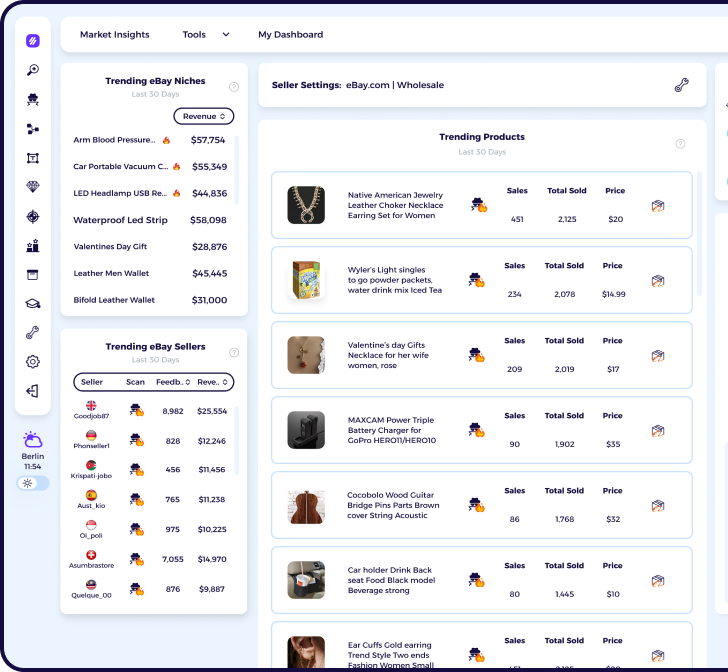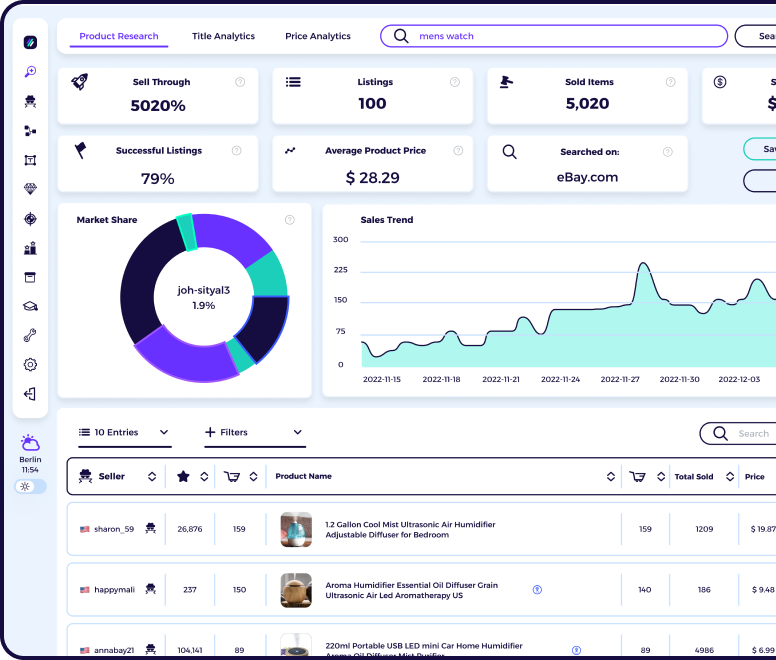The eCommerce business has been booming lately with more businesses turning to the internet to buy and sell products. According to Statista, the eCommerce market value is expected to hit over $8.1 trillion by 2026. In essence, it’s a business model that’s here to stay and brings massive profit to business owners that catch the trend early.
To begin, finding the perfect digital home to sell your products is the first crucial step to ultimate success. However, among several eCommerce platforms across the internet, Shopify and Etsy are among the popular marketplaces business owners can leverage to sell their products online.
Shopify favors large-scale businesses, allowing sellers to easily create a customizable online store. Meanwhile, Etsy connects small businesses that sell homemade, vintage, craft supplies, and other unique items to a built-in community of buying customers. Understanding how each platform works will enable you to develop your business and boost sales.
Therefore, if you are looking to choose either Shopify or Etsy, this article will show you the necessary things to help you determine which one is best for your needs.
Article Overview
What is Shopify?
How To Create A Shopify Store
Set up your store
Add your products
Set up your payment and shipping
Sell on multiple sales channels
What is Etsy?
How to create an Etsy shop?
Shopify vs Etsy: Pros and Cons
Shopify
Etsy
Shopify vs Etsy: Similarities And Differences
Strategies to sell better on Shopify
Strategies to sell better on Etsy
Conclusion
What is Shopify?
Shopify is an e-commerce platform that allows businesses to set up an online store to offer their products or services for sale. With a customer rating of 4.6 out of 5, Shopify hosts over 4.8 million (Accurate as at Jan 2024) stores online and ranks as the second-best platform on the market, right behind Wix.
How Does Shopify Work?
As a Shopify seller, you expand your online presence through a variety of platforms, such as social media and online marketplaces. Additionally, you’ll be able to combine all your sales on a single platform.
How To Create A Shopify Store
Sign Up on Shopify
To get started, go to Shopify.com to create a new account. Shopify allows its users to use the platform on a 14-day free trial without adding a credit card.
In the signup process, you’ll have to provide basic information about yourself and your business, such as your email, password, location, and store name which will be the default URL, your store name.myshopify.com. However, you can also buy your own domain, yourstore.com.
Set up your store
Shopify stores come with a default theme. Customize your store to reflect your brand values with over 70 store themes available to choose from. It’s just a drag-and-drop interface you can quickly get used to.
Add your products
In the products section on the Shopify dashboard, select the ‘Add Your Products‘ button to add your product title, description, price, image, and other relevant information.
Customers want all possible information about the products they are buying to trust your brand. If you don’t know what to add, check your competitors for more inspiration.
In addition, add your product policies and you can get policy templates that Shopify provides.
Set up your payment and shipping
After adding your products, set up your payment and shipping options. You can accept a variety of payment methods with Shopify pricing, including credit cards, PayPal, Apple Pay, and Shopify payments.
Under the settings pages, you’ll also need to configure your shipping rate options and sales tax information.

Sell on multiple sales channels
With Shopify, you can drive traffic from diverse sales channels like Google, eBay, and Walmart, and social media platforms like Instagram, Facebook, Pinterest, Tiktok, and other social networks.
Further, change your store currency, get a Shopify plan, and activate the customer privacy app. Connect your sales channels and manage your sales, deliveries, and orders on the go using the in-built tools on your Shopify dashboard.
You’ll get to embed your web store link using the Buy button tool and Shopify POS to process payment. It helps you track your business’s success and attract more customers.
What is Etsy?
If you are looking for a platform to sell your handmade, vintage, or unique goods online, Etsy could be the perfect solution for you. Moreso, the marketplace has been around since 2005, a year before Shopify was launched.
How does Etsy work?
Etsy is a simplified online marketplace than Shopify. You only need to set up an Etsy store to list your unique products so that buyers can see your products, purchase from you, and leave feedback.
How to create an Etsy shop?
Open an Etsy Account
Go to Etsy.com, and click on ‘Open Shop’ in the top right corner. Add your personal information like name, email address, username, and contact information. Set up your shop name, language, working hours, country, and currency.
Add Your Product Listings
In the process, add your Etsy listings with relevant information like your product image, icon, store cover photo, your about section, and description using keywords buyers will likely search.
Choose Your Payment And Shipping Options
Choose your payment options and set up your billing information. Also set up your shipping options, including rates and processing times.
Set Up Your Store Policy
Ensure your shop policy provides clarity and fairness to buyers to build trust and protect your brand.
Review And Publish Your Shop
Start promoting your shop through social media, word of mouth, and other channels to attract buyers.
Shopify vs Etsy: Pros and Cons
Shopify
Pros
Shopify helps you create and customize your business store: With Shopify, you can create and design your own website and have total control over your store and listings, and can easily manage them on your Shopify dashboard.
It helps you enhance your brand: You can add your unique logo, and color, and build an online presence that aligns with your brand.
It helps you improve customers’ experience and support: Shopify offers 24/7 customer support so whenever you need help with technical issues or business advice, you can contact the support team via email, phone, and live chat.
Shopify is a secure and reliable platform: When you create your website on Shopify, it is hosted on a cloud network where it can not crash, unlike servers where it can crash especially during big online events sales.
The marketplace offers a payment gateway: Shopify offers a range of payment gateways, including Shopify Payments, which allows users to accept credit card payments directly through their store. Shopify also supports third-party payment gateways, including PayPal and Stripe.
Shopify offers special features to promote your business: Shopify is highly scalable with its range of features you can access to manage your inventory, process payments, handle shipping and fulfillment, and monitor your store performances.
Shopify offers low entry fees: As a seller on Shopify, there’s always the right plan that fits right in your budget. You can opt for the Shopify Starter for $5 a month, and as your business escalates, you can opt for Shopify Plus.
Cons
Shopify charges monthly fees: To sell on Shopify, you’ll have to pay monthly which may not be effective for businesses that are not generating enough sales.
You may encounter several technical problems while designing your website: Though there are templates available, you may need to hire a developer or contact the support team.
Shopify charges for each product sale: After every successful sale, Shopify will charge you transaction fees apart from monthly payments which may affect your profit margin.
Etsy
Pros
Etsy is a user-friendly and easy-to-use platform: Unlike other e-commerce platforms, you can easily create an Etsy seller account and navigate the platform to set up and manage your shop, list items, process orders, and communicate with buyers.
You can access a large and specific audience:
With an average traffic of 377.4 million monthly, Etsy sellers have access to millions of active buyers around the world. It’s a niche market where you can reach interested buyers since the marketplace focuses on unique handmade and vintage items.
Etsy offers a range of resources and support for sellers: You can get educational materials on Etsy, join seller forums to meet other sellers like you, and can also contact the customer support team. It’ll help you develop your creativity and ask questions.
Cons
Etsy users only accept payments through the Etsy payments processing system: Etsy payments enable you to accept credit cards, Apple Pay, Google Pay, and Paypal in 54 countries. Making the platform limited to some sellers.
There’s limited brand control: You can only customize your shop appearance to some certain extent on Etsy, making it difficult to express your brand identity.
Shopify vs Etsy: Similarities And Differences
Similarities
Online storefront
You can create an online storefront on both platforms to showcase and sell your products.
Payment processing
Etsy and Shopify offer built-in payment processing, allowing you to accept payments from buyers.
Shipping and fulfillment
Both platforms offer tools for managing shipping and fulfillment, including printing shipping labels and tracking packages.
Customer support
Sellers on both platforms get access to quality customer support via email, phone, or live chat.
Integration with third-party apps
Both platforms offer integration with a wide range of third-party apps and tools including the Shopify app store and the Etsy app. It allows sellers to extend the functionality of their stores.
Analytics and Reporting
There are built-in analytics and reporting tools on both platforms which helps you track sales, monitor customer behavior, and optimize your store.
Standard Policies
Both Shopify and Etsy have a standard platform policy to guide their sellers. So you have to operate within their set rules.
Differences
Shopify and Etsy are both e-commerce platforms, but they have some key differences:
Market Niche
Shopify offers a standalone online store that allows businesses to create their online stores and sell diverse products on multiple marketing channels including jewelry, apparel, handmade goods, and others. Etsy is a specific marketplace that connects buyers and sellers of unique craft supplies.
Custom website
With Shopify, you can have a custom domain and website where customers can visit and make purchases. Etsy offers limited control over your shop’s appearance so you don’t need a domain name or a customized website.
Customer Base
While selling on Shopify, you’ll need to drive traffic to your web store and turn them into buying customers. Meanwhile, Etsy provides a ready-made audience of buyers who are interested in handmade and unique goods.
Pricing
Etsy pricing offers a free standard plan, $0.20 per listing, and a percentage sale of 6.5%.
Shopify charges a monthly starter, basic, standard, advanced, and Shopify plus plan for $5, $32, $92, $399, and $2000 respectively
Customers’ information
With Shopify, you can get your customers’ email addresses to market to them, however, Etsy only provides a physical address to ship products.
Inventory
Shopify is suited for businesses with a larger inventory and more complex needs, while Etsy is best for small-scale businesses.
Features and marketing tools
Shopify offers a wider range of features than Etsy from managing store performance, listings, processing orders, and communicating with buyers to handling different sales channels in a place and monitoring sales.
Strategies to sell better on Shopify
Leverage email marketing
According to statistics, email marketing is the most effective approach to your target market. It helps you to strategically market your products to your clients and deliver them personalized messages.
Share customer reviews
Customers are more likely to trust you after reading reviews. Include reviews on your product pages, email marketing campaigns, and social media platforms.
Invest in blog content
Blog content that ranks high on Google will direct the right customers to your shop. Conduct keyword research on keywords potential buyers are searching for and optimize it in your blog content
Ensure your website is easy to navigate and user friendly
Design your website for buyers to navigate easily and find similar products that interest them.
Optimize your website for mobile viewing
Statistics show that there are more than 4.2 billion active mobile browsers on the internet, which implies that if your web store is not mobile-friendly, you are missing a lot of prospective clients. Make sure your product photographs are crisp and set up for mobile viewing.
Strategies to sell better on Etsy
- Optimize your product listings
Adding new listings to your shop should be your goal. Use relevant keyword titles and descriptions to improve your search engine rankings within Etsy and ensure your product has clear, attractive images and detailed descriptions that’ll help attract potential buyers and increase sales.
- Leverage Etsy’s features
Etsy offers several available features that sellers can use to improve their sales, such as Etsy Ads, Promoted Listings, and Etsy’s free shipping guarantee. However, ensure you are not spending more than your profit.
- Offer promotions, gifts, and discount codes
Customers are more likely to come back when they receive a gift after purchase. Moreso, you can create coupon codes for a limited-time offer to make them buy from you faster.
- Provide exceptional delivery and customer service
Giving your consumers the best possible service and quick replies to inquiries can help you gain their trust and loyalty, resulting in more sales and favorable reviews.
- Promote your products on social media channels
You can attract interested buyers to your shop by creating helpful content about what you sell and showcasing your products, ratings, and reviews on social media platforms like Instagram and Facebook. It helps to enhance your brand image and build relationships with potential customers.
- Offer special product bundles
Merging two or more products for a reduced price helps to increase sales. It could be a jewelry set or a collection of art prints that’ll encourage buyers to take action.
Conclusion
Shopify is great for large-scale business owners who require a scalable and reliable e-commerce solution and complete control over their branding and customer experience. Etsy, on the other hand, makes money doing what they enjoy while also promoting creativity in its products.
Undoubtedly, choosing the right eCommerce platform to sell is hinged on your business goals and products. Whether you are an experienced seller or you have no experience selling online, Shopify and Etsy are two popular marketplaces that will help you streamline your business rand integrate the tools you need to grow.















